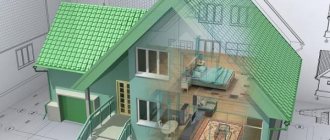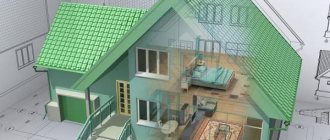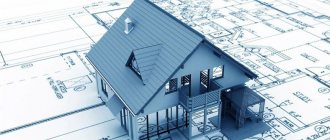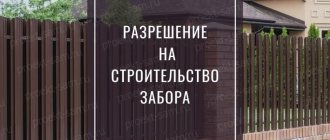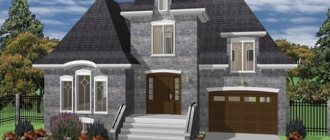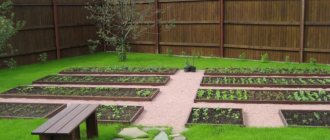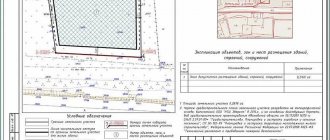Friends, hello everyone! I decided to touch on the topic of building a house because there is too much information on the Internet, of varying degrees of usefulness, on this subject. And it’s quite difficult to immediately select the right one for a non-professional. You have to sit for a long time, rummage through materials and filter out nonsense or manipulation. If you type “how to choose a plot” into a search engine, then the first couple of pages you will receive paid materials from real estate agencies whose purpose is not to provide reliable information. The purpose of such material is to lead the reader to the idea of buying a plot of land from the site owner or advertising company. In addition, it is useful to know the information so as not to fall for the tricks of dishonest construction organizations or realtors.
Important note! I am not a builder or an engineer by training. I just came across this issue from personal experience and want to help other people save money, time and nerves. Along the way, I will provide links to materials I liked on this topic. If you have any questions or additions while reading, or find errors, please leave your comments under the post so that other readers receive the most useful and reliable information.
Tip 1 - choose a city or suburb
Of course, who among us would not want to live in the center, preferably in a green area, and even in our own home.
Shopping centers are at hand, medical centers to choose from, educational and cultural and leisure institutions are also nearby. And the air is good, not like near city highways, where there are eternal traffic jams and congestion. But the relationship between just land and land intended for individual residential construction is much more complex - there are dozens of factors that affect the value of a land plot in addition to its location. On average in Russia, the price of a land plot within the city is 5 million for 10 acres, while the same 10 acres in the suburbs will cost 500 thousand rubles, that is, 10 times less. It is the price that becomes the decisive factor when the question arises of buying land in a city or suburb.
If you have money, then do not save on buying a plot of land, because... The market value of a home is determined only by the standard of living around it. In other words, the richer the neighbors, the more expensive your land plot.
How to choose the best land plot for individual housing construction in the Moscow region
Where and from whom to buy land for building a house?
You can purchase land from another owner - an individual. It is also possible to purchase land from the developer of a new village (in this case, the transaction can be carried out in the form of a purchase from an individual). You can also buy land at auction - directly from municipalities. It is often said about such transactions that the land plot is purchased from the state. When purchasing from individuals, there are certain risks:
- The threat of poor quality documentation.
- Infringement of the rights of a third party.
When purchasing land in an organized cottage community (if you enter into a deal at an early stage), there are always risks of unfinished construction. There are also risks of large maintenance payments. Often, while the village is under construction, there is no charge for maintenance, but after its completion you may face high tariffs. To participate in the auction, you will need certain skills and available funds, which will need to be paid as collateral. It is also not a fact that auctions will be held in those territories that will be potentially interesting to you.
Tip 2 - decide which is better: individual housing construction, private household plots or SNT
“Lomov. If you please remember, my Oxen Meadows border on your birch forest. Lomov. No, you are mistaken, dear Natalya Stepanovna, they are mine. Natalya Stepanovna. Come to your senses, Ivan Vasilyevich! How long have they been yours? Lomov. How long ago? As far as I can remember, they have always been ours. Natalya Stepanovna. Well, let's put it that way, sorry! Lomov. I'll show you the papers! (A.P. Chekhov “The Proposal”)
Little has changed since Chekhov's times: the dacha remains a dacha. And the question is not only about money - the question is about the culture of life. Although, if we compare prices in cottage villages for individual housing construction with prices in SNT, then land in non-profit gardening partnerships will be 2-5 times cheaper.
Land for individual housing construction is more expensive, but you get:
- the ability to manage your plot without the collective participation of the chairman and other gardeners;
- clear and correctly delimited boundaries of the site (there will be no dispute with neighbors);
- the opportunity to obtain a ready-made developed infrastructure (gas, water, sewerage, security, Internet);
- the opportunity to register and receive social services (medicine, school, kindergarten, firefighters, Ministry of Emergency Situations, etc.).
If you bought a summer cottage plot to build a house, then be prepared that in order to live a full life you will have to spend additional money on access roads and utility networks, and such investments can easily equalize the cost of a plot for individual housing construction with a plot in SNT. In addition, you will have to become a member of a gardening society and sometimes carry out the not-so-reasonable decisions of other summer residents.
A plot of land for individual housing construction or private plots – which is better?
Is it worth buying a plot of land in SNT
The importance of assessing the entrances to the site
Despite the fact that assessing the quality of a road is not so difficult, even a surface that seems good at first glance can have pitfalls.
- Asphalted surface . If it is whole, then this is the most favorable option. But bad asphalt makes such a road equal to a dirt road; the difference will only be in the depth of the puddles.
- Dirt road . The saddest option. After rain, the road turns into an impassable swamp, and heavy vehicles leave deep ruts on it. It will be possible to drive through only in dry weather. If the soil is sandy, then there will be significantly fewer problems, because the water is quickly absorbed.
- Concrete covering . This road is flat, but driving on it is uncomfortable due to the seams between the slabs. The car will not be able to reach speeds above 40 km/h, and it feels as if you are driving on a washboard. At the same time, passengers are nervous, and the increased load on the car’s suspension leads to its premature wear.
- An embankment road . This type of coating is very common. In this case, crushed stone or asphalt chips are poured onto the primer. A fresh road looks quite decent, but over time it sags. Problems will arise the faster the less well the sand cushion is made. It is impossible to estimate in advance how long the road will last, because the sand layer is hidden under the rubble. So the service life of a causeway is an equation with several unknowns. In any case, even if the work is done efficiently, the service life of the embankment road does not exceed 4 years. Then the coating will have to be repaired and updated. It is worth asking your neighbors who is responsible for maintaining the road. It's good if these are local authorities. But it may also happen that neighbors carry out work at their own expense. This needs to be clarified in advance in order to have an idea of the upcoming costs.
- Water objects . If the road to your site leads through rivers and ponds, then you need to take a closer look at the bridges and dams located on them. Thus, a low dam, the level of which is only 1-2 m above the water surface, can pose problems in the spring, especially if the area is hilly. During high water, even a small stream can turn into a rapid stream flowing along the road. In this case, you should not even try to drive, because the car may simply be washed away. Then you will have to look for detours, and it is possible that they will not be close. Or the area faces isolation until the flood passes. The situation over the past 10 years should be clarified with local residents.
Tip 3 - choose an environmentally friendly area
In my opinion, ecology is the second most important factor (after price). The cleanliness of the air and the absence of harmful impurities in it are affected by the activities of industrial enterprises, proximity and congestion of roads. As a rule, industrial zones are concentrated in certain areas of the city, but there are also single-industry towns where it is impossible to hide from the factory smog. As for highways, there is no definite answer here, since roads are constantly expanding and new ones are being added. To be on the safe side, it is better to refer to the urban planning plan of the territory where you have your eye on the site.
The presence or absence of forests near a suburban area also influences the choice. It’s always good to plunge into the coolness of a coniferous forest or walk through a birch forest to pick mushrooms, or pick raspberries and strawberries in sunny meadows. But just 2-3 such trees on your site can become a real problem - cutting down requires a documentary permit (cutting ticket) and a gigantic effort to uproot.
Trees on the site are great until it comes to construction...
Is it worth buying a plot of land in a water protection zone?
Providing electricity and gas
If the land plot is connected to the power grid, the district administration needs to find out what power you can count on in the future. Due to overloading of power grids, the released energy may not be enough for household needs. The shortfall in energy consumption will have to be made up on your own (generator, small substation, solar or wind energy sources). This is a very expensive project that will seriously hit the budget.
An excellent solution would be to have a central gas pipeline. Installing a boiler for heating and water heating will greatly simplify life.
Tip 4 - Study the infrastructure
Infrastructure and utilities are in third place in my mini-rating, and the most important thing here is electricity.
Electricity supply
Formally, connecting electricity to a plot of land costs about 600 rubles, but in practice this amount can increase 100 times or more. This is due to the lack of ability or desire of local authorities to extend power grids at budget expense. In this case, the installation of an electrical substation (transformer), the purchase and installation of power line supports, the purchase and tension of wires fall on the shoulders of the owners.
Gas supply
The second most important utility network is gas. The cost of gas in cylinders is significantly higher (now a 50-liter cylinder costs about 800 rubles) than the cost of natural gas. In just one, not the coldest winter, heating a house of 150 sq. m of bottled gas will cost 80,000 rubles, whereas for mains gas you will pay only 10,000. Connecting a house to a gas pipeline rarely costs more than 150,000 rubles.
Water supply
Most private developers, when choosing a land plot, for some reason forget about water supply. There are cases when only after construction people realize that the water in the well they drilled is extremely ferruginous. Iron content can be 30 times higher than normal. Such water is not suitable for technical needs or for drinking, and filtration will cost a pretty penny. The most effective way to avoid such a situation is to obtain information about water quality from future neighbors.
Sewerage
It may be central, but installing a septic tank on the site costs no more than 35,000 rubles. To save money, you can install one septic tank for two houses together with neighbors.
How to choose a septic tank for your home
Driveways
The ideal option is when the street runs along an asphalt road maintained by the municipality. But unpaved access roads are also a working option. The quality of such a road is best assessed in the spring, when the snow melts.
The ability to connect electricity, water, gas, sewerage, the presence of roads, schools and shops create conditions for a comfortable existence and make positive adjustments when valuing the land. You need to understand that life becomes very complicated when at least one of the listed communications is missing in the house.
Geodetic features of the territory
- Relief. Small distortions can be eliminated relatively easily (technology is implied, but not costs) - by leveling the ground, choosing the right foundation, or raising the base. But if the slope is 100 cm or more, the cost of building 1 m² of house foundation increases sharply.
- Soil characteristics. The choice of type (and therefore cost) of foundation largely depends on this.
- Location of underground water. Therefore, how much will it cost to develop a well (well) and whether the source will be able to fully meet all the needs of the owner of the site.
Tip 5 - Check the geology and terrain
It is clear that you cannot build on a swampy area, just as you cannot build if:
- groundwater lies very close;
- very low density of the earth (the house may sink);
- Clay soils are of little use.
Significantly more expensive construction:
- An area with difficult terrain - a steep slope in one direction or a dip in the middle;
- If there is a river flowing near the site, the peculiarity of which is a wide flood in the spring (the house can flood).
Soil testing
A soil study on the plot of land selected for individual housing construction should be carried out even before signing the contract. Based on this data, a project for the entire building will be created and the type of foundation selected. The research is carried out in any case, and especially carefully when the price is too attractive for a prestigious area.
It is important to find out whether the area is flooded during river floods, prolonged heavy rains, as well as what the groundwater level is. You can find out this from your neighbors or by making several deep holes at different ends of the site. If water appears in them in one hour, then groundwater passes very close to the surface. In the future, it will be necessary to build a drainage system.
The condition of the soil and the proximity of groundwater are important facts, but you should not rely only on them when making the final choice. There are no ideal sites, and all disadvantages can be turned into advantages by adapting them to the conditions of the area. Specialists from the architectural bureau will help solve all problems.
Tip 6 - check the site with the builders
The site should have simple shapes and equal proportions: not too narrow and not too long. Immediately discard curves, obliques and other forms unsuitable for construction. Ideally, this is a square plot with a ratio of 1 to 10. That is, if you are planning to build a house with an area of 150 square meters. m, then the ideal land area should be at least 1500 sq. m. m or 15 acres. But, in fact, a 2-story house with an area of 150 square meters fits perfectly on 4 acres.
Keep in mind that the shape and area of the site will be a key factor in the design and construction of the house.
On my own behalf, I recommend paying attention to the projects of one-story houses. Living in a one-story house is convenient, and the market value of sq. m. meters will be 20-30% higher than that of a two- and even more so a three-story individual residential building.
conclusions
To choose a site for building a house for permanent residence, study in detail the information about the locality where it will be located, the map and development plans. Feel free to chat with locals. Do not consider the site without geological surveys and documents confirming this.
Land plots from Navigator are sold with all the necessary studies carried out, communications provided, and high-quality road surface to the entrance. All cottage villages have a checkpoint at the entrance, and are also under the supervision of a service company that monitors cleanliness.
Tip 7 - choose the right form of ownership
Pros and cons of owning a plot of land
When purchasing land as your own, you receive a certificate (since 2016, this function is replaced by an extract from the Unified State Register), a guarantee of the legal purity of the transaction and peace of mind. Although no one will give you a 100% guarantee here either. There are known cases when plots were seized for state programs (construction of a highway, installation of power lines or gasification), and no certificates of ownership helped.
However, the new owner is subject to tax obligations: land tax for individuals (0.3% of the cadastral value per year) and tax on the sale of property (13% of 70% of the cadastral value of the property). In this regard, purchasing a leased plot also has a number of advantages.
Try not to pay taxes and you will find out who really owns your property - © David Rockefeller
Pros and cons of rented land
If you leased a plot of land from the administration or bought a plot under an assignment of rights agreement, then you will only have to pay rental payments (about 0.3% of the cadastral value of the plot per year). But, again, you need to take into account how much you will pay for the purchase of a land plot from lease to ownership. In accordance with the Civil Code of the Russian Federation and the Land Code, the redemption value of a land plot within the city can reach 15% of the cadastral value, and 3% outside the city. It is possible to transfer a plot of land from rental to ownership only after the construction of a house, garage or bathhouse on its territory.
It happens that it is impossible to obtain ownership of a land plot. For example, land is reserved for bidding for the development of the territory, for purchase by preferential categories of citizens, or for municipal needs. As a rule, this scares future tenants. If you also have concerns, it is better to buy a plot of land as your own.

